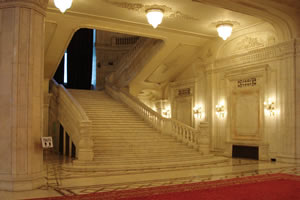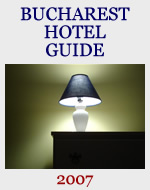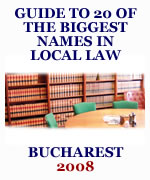Gap in market for conference space
Summits for NATO and Francophony have raised interest in Romania as a site for international conferences: but does the city have the capacity to support the demand? Asks Corina Ilie
 |
|
|||||||||||||
Seating provided by all the hotels
and convention centres in Bucharest
is not enough to support the
rapid development of the highly profitable
conference and exhibitions industry.
Bucharest has 35,000 seats in all
its scattered venues over the city and
every year hosts around 2,000 conferences,
of which around 600 include
over 100 participants.
The industry is booming by around
20 per cent per year and has an annual
value of 30 million Euro. This accounts
for the largest share of the profi t generated
by the tourism sector, according to
Paul Marasoiu, head of the Romanian
Convention Bureau.
These are attractive foundations for
an industry Bucharest can build upon.
Now the International Conference
Center Palatul Parlamentului in Ceausescu’s
former People’s Palace and the
venue for the Communist’s annual congress,
Sala Palatului, are the largest
conference facilities in the Capital.
Although centrally located, these two
buidlings were erected between 1970 and
the 1990s and do not have the necessary facilities
and technology for a modern centre.
Sala Palatului has one room with
4,060 seats, but only a small second
room holding 350 seats in a theatre arrangement.
The 4,070 seats inside Palatul
Parlamentului are distributed in
12 rooms of which the largest has only
1,200 seats in a theatre arrangement.
This year’s NATO Summit, with
3,000 delegates, the Francophony Summit
in 2006 with 2,500 participants and
the International Postal Congress, with
2,500 in 2005, were the largest conferences
held in Bucharest. All used the
state-owned Palatul Parlamentului.
“This venue, despite its overwhelming
dimensions does not meet the proper
international standards,” says Traian
Badulescu, spokesman for the National
Association of Tourism Agencies. “A convention
centre should have a large conference
room with 5,000 to 6,000 seats
where the plenum meetings can be held
and several other smaller rooms, with the
same cumulated capacity that can host
smaller sessions on different subjects.”
A five-day international conference
with between 500 to 600 participants,
including conference room rent, hotels
accommodation, airport transfer,
catering, social events, equipment and
translators costs around 500,000 Euro
to organise, according to the Romania
Convention Bureau.
The organisers gain a small percentage
of the revenues, to cover some expenses
related to the event and a small
profit. Service providers such as hotels
cash around 85 per cent of the revenues,
while the state and city benefit from
taxes. Meanwhile the delegates splash
out their own pocket money or expenses
as though they were on holiday.
Proximity to hotels and easy links
to the airport and the city centre are a
necessity for conference centres. With
this in mind, British-owned Willbrook
Management International has started
the development of a business and
convention centre, which will provide
by 2009, 63,000 sqm of office and
convention facilities for more than 3,650
guests in fi ve rooms on the national road
from Bucharest to Ploiesti, for a delivery
date of 2009
“When travelling abroad, for a
conference, a lot of people prefer to fly
back to their country in the same day,”
says Pierre Boissel, general manager of
Crowne Plaza Hotel. “So a convention
centre located in north Bucharest close
to both international airports could be
successful.”
Building from scratch a construction
with several conference rooms can
prove to be a more cost-effective solution
than rehabilitating an abandoned
site. “Old buildings are an option, but
probably it would cost more to transform
them,” says JW Marriott’s general
manager Kurt Strohmayer.
Casa Radio, near Eroilor Boulevard,
where the Dambovita Center project is
under construction, could be an excellent
location for a convention centre,
according to the Radisson SAS Hotel’s
general manager Torbjorn Bodin. “It is
central, close to the hotels and has excellent
transportation links,” he says.
Necessary measures
Effective audio-visual infrastructure and
high quality equipment are compulsory
elements that state-owned conference
centres cannot always afford to provide,
while four and fi ve-star hotels are able to
make larger investments.
“A modern conference facility should
be multi-functional, adjustable for meetings,
conferences and social events like
dinners and parties,” argues Torbjorn Bodin.
“It should have a good ceiling height,
a good audio-visual infrastructure with
platinum screens and cameras built in.
Everything has to be inside and as few
things as possible should be brought from
outside in order not to spoil the initial arrangement
of the facility.”
To this list, Kurt Strohmayer adds
good lighting, air control and technical
support. “Most importantly, high quality
staff that can provide guests with anything
they need all the time,” he adds.
Space to rent
Sala Palatului, 28 Strada Ion Campineanu:
one room with 4,060 seats and a small
second room holding 350 seats in a theatre
arrangement.
Palatul Parlamentului, Calea 13 Spetembrie
entrance:
4,070 seats in 12 rooms of
which the largest has 1,200 seats in a theatre
arrangement.
JW Marriott Grand Hotel, 90 Calea
13 Septembrie:
2,000 guests in two ball
rooms, foyer and ten meeting rooms.
Rin Grand Hotel, 7D Calea Vitan-Barzesti:
1,500 seats in 36 rooms.
Radisson SAS Hotel, 63-81 Calea Victoriei:
1,000 people in 12 conference rooms
of which the largest has a capacity of 500.
Crowne Plaza Hotel, 1 Strada Poligrafiei:
900 seats in ten conference rooms, with a
crown ball room that is due for an extension
programme.
Intercontinental Hotel, 4 Blvd Balcescu:
six meeting rooms, four offi ces which can
host a total of 1,500 in a reception format,
which will also begin a refurbishment this
Autumn.

















